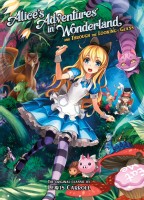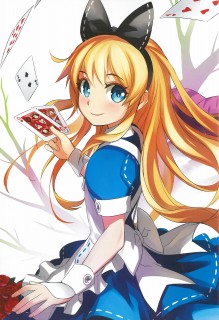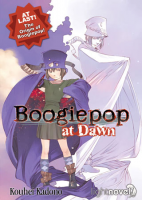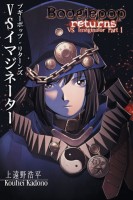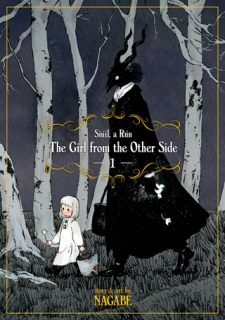 Creator: Nagabe
Creator: Nagabe
Translator: Adrienne Beck
Adapter: Ysabet Reinhardt MacFarlane
U.S. publisher: Seven Seas
ISBN: 9781626924673
Released: January 2017
Original run: 2016
The Girl from the Other Side: Siúil, a Rún by Nagabe was easily one of my most anticipated manga debuts of 2017. Nagabe is known as a creator of somewhat unusual or unorthodox manga, The Girl form the Other Side easily fitting into that category. (Nagabe’s work was actually first brought to my attention thanks to a series of beautifully drawn boys’ love doujinshi featuring birds.) The first volume of The Girl from the Other Side was originally published in Japan in 2016, while the English-language edition was released by Seven Seas early in 2017. The quality of the physical release is admittedly a little disappointing–the cover stock feels ephemeral and ink tends to smudge and transfer between pages (granted, this does at least seem to be thematically appropriate)–but I’m thrilled that The Girl from the Other Side is being translated at all. It’s also worth noting that the manga does share some obvious parallels with another unusual series, Kore Yamazaki’s The Ancient Magus’ Bride, but even considering their similarities they are quite different from each another.
Once upon a time, two kingdoms existed in a world divided into the Outside and the Inside. Humans live on the Inside behind a wall intended to keep the monstrous Outsiders and the dark curse associated with them at bay. Coming into contact with an Outsider is to be avoided at all costs; to do otherwise means risking ones’ life and humanity. But the darkness of the Outside is slowly encroaching upon the light of the Inside. Humans are succumbing to a cursed disease and are abandoning entire villages as they unsuccessfully try to flee from it. Out of fear and suspicion, people have started to turn against one another in a desperate effort to survive. In the midst of this turmoil is a young girl, Shiva. Unexpectedly left behind in an area which is now considered a part of the Outside, she is waiting to be reunited with her family. In a peculiar twist of fate, Shiva is being guarded and cared for by an inhuman Outsider who she simply calls “Teacher.” The circumstances are unusual and dangerous for them both as Shiva’s safety becoming more and more difficult to guarantee the longer she remains on the Outside, set apart from others.
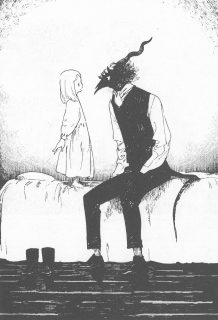 The fact that Shiva’s very life is in danger is clear from the beginning of The Girl from the Other Side. As a sort of prologue, the manga opens with her being warned of the curse brought by the touch of an Outsider while the first panel of the story-proper shows her lying listless on the stump of a tree. She has only fallen asleep, but the visual cues of the scene are closely reminiscent of death. An ominous feeling of uncertainty–is Shiva actually alive or is she dead, how much of her world is real and how much of it is a fairytale–pervades The Girl from the Other Side. Shiva is young enough that she doesn’t completely understand everything that is happening to her and doesn’t know enough to be afraid. But as she experiences more her awareness grows, even when Teacher tries to shield her from life’s harsher realities. Likewise, readers gain more knowledge as the underlying truths of Shiva’s situation are slowly revealed. However, they don’t have Teacher to soften the blows for them. To some extent Shiva’s innocence protects her from the tragedy and heartbreak inherent to The Girl from the Other Side which is so obvious from an outside perspective.
The fact that Shiva’s very life is in danger is clear from the beginning of The Girl from the Other Side. As a sort of prologue, the manga opens with her being warned of the curse brought by the touch of an Outsider while the first panel of the story-proper shows her lying listless on the stump of a tree. She has only fallen asleep, but the visual cues of the scene are closely reminiscent of death. An ominous feeling of uncertainty–is Shiva actually alive or is she dead, how much of her world is real and how much of it is a fairytale–pervades The Girl from the Other Side. Shiva is young enough that she doesn’t completely understand everything that is happening to her and doesn’t know enough to be afraid. But as she experiences more her awareness grows, even when Teacher tries to shield her from life’s harsher realities. Likewise, readers gain more knowledge as the underlying truths of Shiva’s situation are slowly revealed. However, they don’t have Teacher to soften the blows for them. To some extent Shiva’s innocence protects her from the tragedy and heartbreak inherent to The Girl from the Other Side which is so obvious from an outside perspective.
The Girl from the Other Side is incredibly atmospheric, a beautiful and surprisingly gentle and charming story which simultaneously manages to be disconcerting and unsettling. The series is very dark, in both theme and illustration. There is a tremendous amount of ink on the manga’s pages–the oppressive shadow of death which haunts the story is reinforced visually, the darkness permeating the scenes. Shiva, with her light-colored hair and dressed in white, stands apart from the unwelcoming environment. She is obviously out of place, separate from what is around her. In contrast, Teacher is clothed in black and at times is barely discernible from the background. But although an Outsider and demonic in form, Teacher is Shiva’s only hope, trying to safeguard her from anyone who would seek to do her harm. Their strange yet sweet and endearing relationship is core to The Girl on the Other Side. The life that they have, no matter how impermanent, carries great weight as they face an uncertain future together. The Girl from the Other Side is a gorgeous and striking work; I can’t wait for the next volume to be released.

